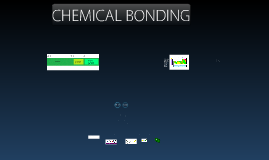Chemical Bonding
Transcript: ex/ Cu Ti Al metallic bonds attract floating valence electrons to metal ions ex/ CaCl polarity covalent 2 2 NaCl types these are examples of electron dot structures 2 It can help us understand more about the electrons involved in each bond and determine the polarity or non polarity of the substance and/or bond the electrons are mobile ex/ H shares its electrons equally, therefore it is a nonpolar covalent bond ex/ HBr shares its electrons unequally, therefore it is a polar covalent bond the bonds conduct electricity, generally have high melting points, and are maleable Why is it important? Atoms bond for lower energy and higher stability Why do atoms bond? CHEMICAL BONDING by Christine Veit the electron dot structure shows the sequence of atoms, the bonded pairs between atoms, and the unshared electrons in valence shells 2 nonpolar covalent bonds are a bond between atoms with similar electronegativities 2 polarity in general depends on the electronegativity of the elements in the molecule, and is based on the polarity of the bonds the bond is usually shared between two nonmetals to form a molecule ex/ polar covalent bonds are shared unequally in a covalent bond metallic covalent & ionic ionic bonds are strong, and occur between a metal and a nonmetal a resonance structure is when two or more electron dot structures are written with the variety of ways that the double bond can be placed metallic electron dot structure ionic H O CO N covalent bonds share electrons ex/ H2 the attraction pulls the atoms closer until they share a pair of valence electrons and form a covalent bond these bonds are solids at room temperature, brittle, are poor conductors of heat, but are able to conduct electricity when dissolved in water or melted covalent bonds are weak, have high melting/boiling points, are brittle, and poor conductors of heat Li O

















